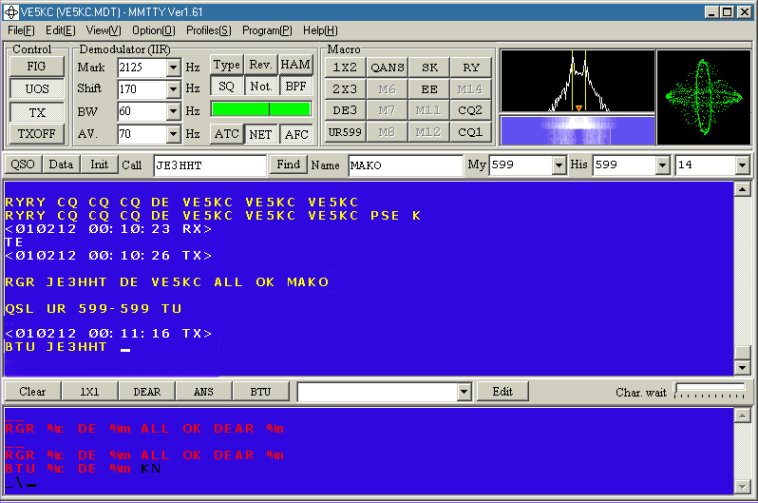
Waterfall display showing four RTTY signalsįSK and AFSK.

The pattern on a classical mark/space tuning indicator should show intersecting ellipses When an RTTY signal is properly tuned in, Sound-clips of RTTY signals with several shifts and Baud-rates are on my Weather stations often use 50 or 75 baud, and a 450 Hz shift. For example, if you say you are transmitting on 14080.00 kHz, that means your MARK frequency is 14080.00 kHz and your SPACE frequency is 170 Hz lower, or 14079.83 kHz. It is customary to refer to the MARK frequency as the frequency you are operating on.

This allows sharp 250-500 Hz audio filtering. For amateur radio, the SHIFT has been standardized at 170 Hz. The difference between the two is known as the SHIFT.

The lower RF frequency is known as the SPACE frequency and the upper RF frequency is known as the MARK frequency. There is no amplitude modulation, only a pure carrier similar to CW with the addition of a frequency shift. A two-tone RTTY transmitter sends out a continuous carrier that shifts frequency back and forth between two distinct frequencies. At the same time, they also proposed Automatic Repeat Request (ARQ), for characters with corrupted signals. Bakker of the Dutch P.T.T proposed the use of two-tone FSK for RTTY. However, RTTY was not FSK until after 1933, when H.C.A. Nowadays, RTTY and Frequency Shift keying (FSK) areĬonsidered synonymous. Teletype punch-tape for "the quick brown fox jumped over the lazy dog back 1234567890 end test" "telex", which is actually a teleprinting e xchange, i.e., an exchange-based switched network service, enabling communication between teleprinters. Sometimes RTTY is incorrectly referred to as These days, (de-)modulation is typically done with freeware on a PC, using the PC's soundcard. ("modem") were not uncommon in a Ham shack, and the easy-to-operate equipment made more amateurs active in RTTY operation. Devices like HAL DS3100, consisting of an electronic keyboard, a monitor and the modulator- demodulator Noisy selector magnets used in mechanical decoders to detect the status of the loop current (mark and space), tape readers, perforators, loop power supplies, were all replaced by a small chip, that made all jobs better. The bulky and noisy US military and commercial surplus equipment (keyboard terminals, teleprinters, punch tape perforators, etc.) became the main equipment for the RTTY radio amateurs right after the war, until microprocessors made their arrival in the 1970s. RTTY was standard during the second Worlds War. With electromechanical teleprinter machines dates back to the1930s. Commercial wireless Radio Tele type (RTTY, sometimes pronounced as "ritty") communication
#Rtty ham radio full
It is currently disabled in your browser! Please (re-)enable it for full functionality. Click here to read about when I acquired the ST-6 and Model 32.My website uses JavaScript for menus etc. My Equipment: So far my RTTY equipment is limited to a HAL-ST6 Terminal Unit, and a Teletype Model 32, which although similar to the infamous Model 33, is a 5-bit “Baudot” machine, originally used for the “ Telex” Network.
#Rtty ham radio software
In most modern cases, a USB audio interface now replaces the “terminal unit”, and software like FLDIGI replace the teleprinter, but as the RTTY protocol uses the old Baudot character set at 45.5bps baud, most older gear still works fine! For example a Model 15 teletype can be used for RTTY, and it first came out in 1930! RTTY usually involves 3 major pieces of equipment your radio receiver/transceiver (most standard ham radios today work with RTTY), a “terminal unit”, and a teleprinter/Teletype. The interesting part of RTTY, is that it’s not only still a fairly popular digital mode amongst many newer, better digital modes, but it’s historically significant that this particular mode can work with equipment that literally dates back to the 1920’s. There’s a bit of crossover here, as Teletypes were not only used for amateur radio use, but often used for computing as well (now vintage computing), so this page is dedicated to the radio side of things, while I may have another page dedicated to the computer use of Teletypes.

#Rtty ham radio how to
It was first pioneered by the Navy, and later amateur radio operators formed groups such as the “ South California Radio Teletype Society” that literally took in cheap and free equipment from companies such as Western Union, and got them in the hands of amateur radio operators who started figuring out how to get them to talk over the air on the amateur bands. Radio Teletype is the evolution of the old “telegram” services from the late 1800s, but instead using “teleprinters” (aka Typewriters) that work over radio waves. This page is all about RTTY, or “ Radio Teletype“.


 0 kommentar(er)
0 kommentar(er)
